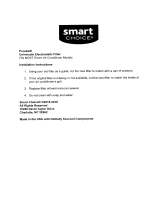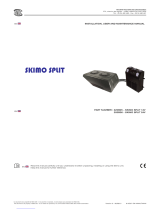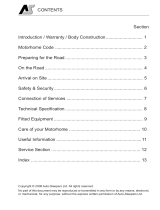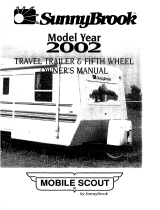
Dometic Environmental Corporation
P.O. Box 15299
Richmond,VA 23227
Phone: 804-746-1313 Fax: 804-746-7248
Email: sales@DometicTruck.com
Website: www.DometicTruck.com
carb-compliant
03-10-08 L2523

I
In this booklet, we’ll explain all aspects of battery-powered auxiliary air conditioning solutions from Dometic
Environmental Corporation.
These rugged systems are thoroughly engineered and field tested to provide years of trouble-free performance.
They’re designed for easy installation without special tools.
The battery-based Dometic aux air systems run on 12 Volt electricity drawn from an on-board bank of batteries
through a DC-AC inverter, or from 115 Volt shorepower when an external power source is available. No internal
combustion engine is required to produce electricity. They use no fuel, emit no air pollution and are virtually main-
tenance free. They are 100% CARB compliant, meeting all of the most stringent clean-air laws without any future
modifications.
At Dometic, we have a 45+ year heritage of designing and building HVAC systems for the harshest environments.
We’re especially proud of our reputation for providing the industry’s best factory support and after-sale service for
our customers. We offer extensive application engineering services to help you select, specify, install and maintain
your auxiliary air systems.
We understand you may have a lot of questions about battery-based auxiliary air technology. To get you started,
we have written this instructional booklet. We encourage you to read it carefully. If there is anything that is
unclear, give us a call, and we’ll be delighted to answer any questions you may have.
Dometic Battery--Powered
Auxiliary Air Solutions
◆ CARB approved
◆ Runs on 12V power from bank of Group 31
AGM batteries
◆ Complies with all anti-idle laws
◆ Suitable for day cabs or sleepers
◆ 7,000 and 10,000 BTU capacities
• Self-contained package units
• Patented split systems with reusable
precharged refrigerant linesets
◆ Heating options
• 1 to 2 KW built-in electric heat
• Interface with installed diesel-fired heaters
◆ No special tools required to install
◆ Turnkey package includes all components
needed to complete installation
◆ Backed by extensive application engineering
support and nationwide service
◆ Designed and built for over-the-road conditions
and thoroughly field-tested

Batteries.
Traditionally, truck batteries are designed to provide sufficient power to start the truck’s engine and to power
lights, blower motors, electrical sensing circuits and other “hotel” loads like a refrigerator or a television set. It
takes much more sustained power to run an air conditioning unit for ten hours (and conform to HOS regulations)
without recharging.This is why Dometic specifies absorbed glass mat (AGM) batteries.These batteries are a proven
technology and are readily available across North America. Dometic’s choices have up to 500 cycles in them (about
2 1/2 years of use) and were selected for their deep cycle recovery characteristics and ability to be recharged rap-
idly.The number of batteries depends on the capacity of the air conditioner, size of the sleeper and the use profile
of the truck.
Alternator.
You will replace your existing alternator with a higher-output unit rated at 185 amps minimum. The size of the new
alternator will depend on the total number of batteries to be charged, and we will provide some guidelines in
Chapter 3. Unlike traditional truck alternators, these units have an external regulator, which acts as a three-stage
charger with a boost phase, a charging phase and a float stage. This regulator is programmed to charge to the
specific requirements of an AGM battery. It has sensors for temperature at the regulator and batteries, and also
for voltage and will use these sensors to protect the alternator from damage. Leece Neville extends a three year
warranty for this alternator and external regulator combination.
Inverter.
Off-the-shelf inverters are generally designed for relatively light loads, for instance,TVs, microwave ovens, coffee
makers and computers. Dometic’s air conditioning systems will draw 70 to 100 DC amps for up to ten hours,
and, there are momentary spikes when the compressor cuts on.We have developed a specific inverter with an
experienced inverter firm that can handle the requirements of an air conditioning system while also being able
to handle the normal house loads. It is available as an inverter/charger and as an inverter only. Both have a low-
voltage cutout to protect the truck’s battery system and ensure re-starting. Dometic’s specified systems have
never failed to start a truck engine.
Shorepower.
Although there are relatively few shorepower hookups available at truck stops, rest stops and terminals, these will
become more readily available in the future. The Dometic all-electric system is designed so that the auxiliary air
conditioning system can run on an external 115 Volt power source, which can also simultaneously recharge the
truck’s batteries when the inverter-charger unit is installed.
Air Conditioning System.
Dometic offers a range of models and capacities designed to meet each truck’s specific profile – its load requirements
and space constraints -- and we will look at these choices on the next page.
The basic principle of an air conditioner is the transfer of heat from one place to another – in this case from the
inside of your vehicle to the outside. This is accomplished by absorbing heat from the inside air into a refrigerant
gas flowing through an evaporator coil. The refrigerant is then pumped to a condenser, where the heat is released
to the outside air. The refrigerant, a chemical with a low evaporation temperature, flows around a closed loop,
driven and pressurized by a compressor. As a part of the cooling process, the air conditioner also removes
moisture from the inside air, which makes the area feel more comfortable and keeps the compartment dry and
mildew-free.
A belt-driven compressor on the truck’s engine supplies air conditioning whenever the engine is running. To keep
the driver comfortable when the engine is shut down, it is necessary to have a separate auxiliary air conditioning
system that uses an alternative source of power.
To that end, Dometic has developed an auxiliary air system that runs on 12 Volt power from an onboard bank of
batteries, using a device called an inverter, which converts the 12 Volt DC battery output into 115 Volt AC power.
It can also run on 115 Volt electricity from a shorepower hookup. No separate diesel genset or other internal
combustion engine is involved. The batteries are automatically recharged by the alternator whenever the truck is
running or from shorepower when used with Dometic’s recommended inverter/charger unit.
In specifying an all-electric battery-powered HVAC system, you should think of it as an integrated solution comprised
of a number of different components, including:
• Heavy-duty deep-cycle batteries, designed for numerous discharge and recharge cycles
• A high-performance alternator with external regulator to recharge the batteries quickly and keep them fully
charged
• A correctly sized and specified DC-AC inverter
• The air conditioning components, with associated ducts, grills, electrical power supply and controls
• Shorepower connection
ThE BASICS

AIR CONDITIONING CHOICES
There are two basic types of auxiliary air systems:
• Self-contained “package” units
• Split systems
The self-contained unit is designed to be wholly mounted inside the truck, usually under a berth or seat or inside a
side storage locker. All of the air conditioning components, including the compressor, condenser, evaporator, blower
and power supply, are mounted on a single low-profile chassis with an aluminum cover. The system’s closed refrigerant
loop is precharged and sealed at the factory. Inside air is pulled across the evaporator coil, and cooled air is blown
through a flexible duct to a discharge grill for discharge into the living area. Hot air is discharged from the condenser
through cutouts in the floorboard.
Dometic’s patented split systems consist of
two separate modules. The outside unit
contains the condenser and cooling fan. It
is bolted horizontally to the underside or
vertically to the back of the sleeper. The inside
unit contains the compressor, evaporator,
blower, power-logic box and other associated
components. The inside unit is mounted
under a berth or seat or in a side storage
locker. The two units are connected by
reusable precharged quick-connect refrigerant
linesets. The system is designed so that
both units automatically charge to the
correct refrigerant pressure as soon as the
linesets are connected. No special tools
are required.
Each approach offers advantages and
disadvantages. A self-contained unit is
simpler to install and maintain, since it
does not have any external refrigerant lines.
It is also less expensive than a split system
of the same BTU capacity. On the other
hand, it takes more interior space, and it
requires cutting holes in the floorboard
for air to flow to and from the condenser.
A split system, on the other hand, has more
installation flexibility and uses less interior
space. It also is quieter, since the condenser
fan is located outside the truck.
Both types of air conditioning systems can
include built-in electrical heat modules. The
heat is blown through the same ducts and
grills and controlled by the same thermostat.
They can also be used in conjunction with a
diesel-fired heater if desired, under control
of the same thermostat.
Whichever type of system you select, it
will come with ducts, grills, condensate
drains, thermostat controls and electrical
wiring.
Heating Capacity Application
1.0 KW 48 in. sleeper
1.5 KW 60 in. sleeper
2.0 KW 72 in. sleeper
Split system inside unit beneath bunk.
Self-contained unit beneath bunk.
Split system outside condensing unit.

Split Systems
Model Cool Capacity
(BTU)
Heat Capacity Control Height
(in.)
Width
(in.)
Length
(in.)
Weight
(lb.)
Cool
Amps
Heat
Amps
Refrigerant
Internal Unit - Evaporator/Heater/Compressor
ECEQ7 7,000 Cooling only Smart digital 11.75 10.25 19.25 53 7.3 n/a R417a
EHCEQ7 7,000 1 KW Smart digital 11.75 10.25 19.25 53 7.3 8.2 R417a
ECEQ10 10,000 Cooling only Smart digital 11.63 11.12 20.19 60 11.8 n/a R417a
EHCEQ10 10,000 7500 BTU
Espar Ready
Smart digital 11.63 11.12 20.19 60 11.8 1.0 R417a
EHCEQ10 10,000 1.5 KW Smart digital 11.63 11.12 20.19 62 11.8 13 R417a
EHCEQ10 10,000 2 KW Smart digital 11.63 11.12 20.19 62 11.8 17 R417a
External Unit - Condenser
ACCD7 7,000 n/a n/a 6.125 11.3125 21.875 10 n/a n/a R417a
ACCE10 10,000 n/a n/a 6.125 12.5 24.5 12 n/a n/a R417a
Self-Contained Units
ASCF7 7,000 Cooling only Mechanical 12.5 15.25 21.5 62 8.5 n/a R22
ASCEQ7 7,000 Cooling only Smart digital 11.94 17.75 24 70 8.9 n/a R417a
ASCEQ7 7,000 7500 BTU
Espar ready
Smart digital 11.94 17.75 24 70 8.9 1.8 R417a
ASCEQ7 7,000 1 KW Smart digital 11.94 17.75 24 71 8.9 9.5 R417a
ASCEQ7 7,000 1.5 KW Smart digital 11.94 17.75 24 71 8.9 13.4 R417a
ASCDQ10 10,000 Cooling only Smart digital 12.5 20.87 28.25 91 12.9 n/a R22
ASCDQ10 10,000 1.5 KW Smart digital 12.5 20.87 28.25 92 12.9 13.9 R22
ASCDQ10 10,000 2 KW Smart digital 12.5 20.87 28.25 92 12.9 18.2 R22

About Insulation.
Before we go any further, let’s talk briefly about insulation. Most truck sleepers today are insulated with a value of
approximately R 1 to R 1.25. Compare this to the insulation of R 30 that is required in most new housing con-
struction. Even the “cold-weather packages” offered with some new trucks only have insulation values of R 2. TMC
recommended practices call for R 4.2 as a standard insulation package and greater than R 4.6 in a premium package.
This standard, once adopted by the industry, will go a long way toward improving the performance of auxiliary air
conditioning and heating systems.
If you are buying a new truck, you should order it with additional insulation. There are also a number of measures
you can take to reduce the heat load in your truck. If you have skylights, cover them. Insulate the floors with foam
under the carpet. Add insulation to the doors. Get heavy-duty curtains to separate the sleeper from the cab.
Cover the windshield and windows with reflective shades when parked. Park in the shade whenever possible.
Switch off heat-producing appliances in the sleeper.
Air Conditioning Units
Your first step will be determining the type of air conditioning units (split or self-contained) to meet your require-
ments and space constraints, then sizing the units to meet the expected heat load.
Sizing the system can be a complicated affair, since it depends on a number of factors, such as the size and shape of
the sleeper, the amount of insulation (see above), the size and location of windows, the color of the truck (darker
colors absorb more heat) and the ambient temperature outside. It also depends on how long you will need to run
the system without starting your truck’s engine. The following guidelines are based on TMC recommendations for
“average” conditions. If you are operating in very hot regions, you may need to consider extra capacity.
Given current insulation conditions, this will usually keep the occupant cool from head to feet when standing, but
will not cool a high-rise sleeper all the way to the ceiling.
Remember that in a battery-powered sys-
tem more BTUs means more batteries.
Batteries
To power your Dometic auxiliary air con-
ditioner, you will replace your truck’s
existing batteries with Group 31 AGM
batteries, which are designed to support
the heavier loads and frequent
discharge/charge cycles.
SPECIFYING THE SYSTEM
For a day cab with limited engine-off times (less than 2 hours), we recommend replacing the existing bank of batter-
ies with an equal number of AGM 31 batteries.
For a typical sleeper, you will replace the existing bank of four batteries with AGM 31 batteries, and also install addi-
tional batteries. See the chart below for guidelines on the number of batteries required.
We suggest adding the extra batteries and tying them to the existing bank – creating in effect a single bank of 6 to 8
batteries. There are protective low voltage devices on the inverter will shut down electrical loads whenever the
batteries reach a pre-set voltage, thereby ensuring that sufficient power is retained for cranking the engine.
In some cases, it may be desirable to install a separator to isolate two of the batteries from the others. This creates
two separate banks – one for “house loads” and the other exclusively for cranking the engine.
One must understand that the effect of adding more batteries on the system. The relationship is not linear. For
instance, if two batteries give you 1.5 hours, it does not follow that three batteries would give you an additional .75
hour. This is why – given battery voltage safeguards – we recommend a single bank of batteries without separators.
Engine Off
Day Cab 42-48" low roof 60" flat roof 60-72" high-rise
7,000 BTU 7,000 BTU 7,000 BTU 10,000 BTU
Note: 14,000 BTU may be used in certain situations where engine-off time is minimal.
Engine Never Off (No Engine-Driven Air Conditioner)
Day Cab Vocational
10,000 BTU 10,000 BTU
Hours Running on House Batteries
(AGM Group 31 Batteries)
# Batteries 7,000 BTU 10,000 BTU
100% Run 60% Run* 100% Run 60%* Run
2 1.9 3.8 1.2 2.2
3 3.4 6.1 2.3 3.9
4 4.9 8.5 3.1 5.6
5 6.1 10.6 3.9 7.0
6 7.3 12.8 5.0 8.7
7 8.9 14.9 5.8 10.2
8 10.2 17.1 6.7 11.6
*Air conditioner runs 60% of the time, cycling off and on as needed to maintain desired temperature.

Alternator/Regulator
Most trucks have a standard 135-amp alternator with internal regulator, which is adequate for keeping the batteries
charged under normal conditions. This is not sufficient, however, for the heavier charging requirements for a bat-
tery-powered air conditioning system. Dometic specifies a high-
output alternator with an external regulator. The regulator acts
as a three-stage battery charger that charges and protects the
batteries through numerous discharge cycles.These guidelines
apply when sizing the alternator:
Inverter
The inverter takes the 12 Volt DC output from
the batteries and changes it to 115 Volt AC
current, which is fed to the air conditioner and
other AC-powered devices. We have tested and
evaluated dozens of different inverters, and we
have selected a 2,000 Watt unit with a modified
sine-wave (MSW) output. This unit includes a
115 Volt pass-through circuit and built-in 50 amp
charger to permit you to run the air conditioner
and recharge the batteries from shorepower
when available. It is also offered as an inverter-
only model without the charger.We developed this inverter in conjunction with a company with wide experience in
this technology, and we have confidence in its ability to start and run our air conditioning systems. Remember,
whenever the air conditioning system cycles on there is a momentary heavy load that the inverter must accept and
hold until the compressor gets past its starting requirement. It’s only a few milliseconds, but it’s very important.
We do not recommend running our air conditioning systems with any inverter not previously tested and approved
by Dometic engineering.
Shorepower
Although there are relatively few shorepower hookups available at truck stops, rest stops and terminals, these will
become more readily available in the future.
TMC recommends a minimum of one 20-amp circuit for shorepower connections. You should use any heavy-duty
power cord with a standard three-prong plug. Remember that there will be a voltage drop across the cord, so you
should use the minimum length necessary to reach your outside power source.
INSTALLING, OPERATING AND
MAINTAINING THE SYSTEM
Installation
Dometic will provide detailed installation instructions with your system. You should make sure you understand
these instructions and follow them completely.
Controls
The Dometic auxiliary air system comes with a standard digital thermostat/display unit. Operation is intuitive and
easy, with up and down arrows to adjust the setpoint and fan speed.
Optimizing Performance
To improve the air conditioner’s performance on a hot day, you can reduce the heat load by parking in a shaded
area, covering the windows with reflective shades to block out direct sunlight and pulling the curtain between the
sleeper and cab. Make sure windows and doors are tightly closed, and turn off any other heat-producing appliances.
Operation and Maintenance
Make sure you inspect the batteries frequently. Check for solid electrical connections. Be sure the cable connec-
tions are good with no corrosion showing. Check for chafing and moisture.
You should inspect and clean the air filter regularly to ensure good airflow across the evaporator coils. You will find
the filter in the return air path, either directly behind the grill or in front of the evaporator coil.
Make sure you do not block the airflow between the return air grill and evaporator coil with pillows, blankets,
papers or other objects.
Check the condensate drain often to make sure water is draining properly. Make sure the drain fittings do not get
clogged.
If you have a split system with external condensing unit, make sure you inspect and clean any debris from the con-
denser coil to ensure good air flow.
Dometic’s auxiliary air systems, both self-contained and split, are designed so that you should never need recharge
the refrigerant loop under normal circumstances. If the refrigerant level ever needs to be adjusted, federal law
requires that it must be done by an EPA-licensed HVAC technician with the proper tools to avoid accidental dis-
charge of any refrigerant gas into the air.
Occasionally check for chafe on outside wires and refrigerant lines (split systems).
Number of batteries Alternator size
6 or less 185 amps
7 to 9 270 amps
10 or more 320 amps
12 gauge cord Up to 25 ft.
10 gauge cord Up to 50 ft.
Advanced alternator
Standard alternator
17
16
15
14
13
12
11
10
9
8
7
6
TYPICAL CHARGING CURVE FOR LEECE-NEVILLE
HIGH-CAPACITY ALTERNATOR WITH AGM BATTERIES

Dometic Environmental Corporation
www.DometicTruck.com
American Transportation Research Institute
www.atri-online.org
ATA Green Truck Intitiative
www.greentruck.com
ATA Technology and Maintenance Council (TMC)
www.truckline.com/issues/governmentpolicy/environment
California Air Resources Board
www.arb.ca.gov
Canadian Office of Energy Efficiency
http://oee.nrcan.gc.ca/transportation/fleetsmart.cfm
Cascade Sierra Solutions
www.casadesierrasolutions.org
Environmental Protection Agency SmartWay Program
www.epa.gov/smartway
Pennsylvania Office of Energy and Technology Development
www.dep.state.pa.us
U.S. Department of Energy Clean Cities Program
www.eere.energy.gov/cleancities
West Coast Collaborative
www.westcoastdiesel.org
Dometic is a customer driven, world-leading provider of innovative leisure products for the caravan,
motorhome and marine markets. Dometic offers a complete range of air conditioners, refrigerators,
awnings, cookers, sanitation systems, lighting, windows, doors and other equipment that makes leisure
life more comfortable away from home.
Dometic also provides refrigerators for specific use in hotel rooms, offices, and for storage of medical
products and wine along with comfort products designed for the over-the-road truck market. Dometic's
products are sold in almost 100 countries and are produced mainly in Dometic's own production facilities
around the world. Dometic has more than 4,400 employees.
PATENTS. 7,171,822 • 7,234,315 B2 • 7,140,192 • 7,316,119 • 7,237,397 B2
-
 1
1
-
 2
2
-
 3
3
-
 4
4
-
 5
5
-
 6
6
-
 7
7
-
 8
8
Dometic Battery-Powered Auxiliary Air Conditioning System User manual
- Type
- User manual
- This manual is also suitable for
Ask a question and I''ll find the answer in the document
Finding information in a document is now easier with AI
Related papers
-
Dometic 14 User manual
-
Dometic ASCDQ10 Owner's manual
-
Dometic Battery--Powered Auxiliary Air System User manual
-
Dometic 2597 User manual
-
Dometic Air Conditioning & Heating Accessories User manual
-
Dometic Truck HVAC Systems Operating instructions
-
Dometic SI 1500 24V Owner's manual
-
Dometic Duo Therm Cab Comfort Heat Pump For Semi-Sleeper 42044.502_42055.502 Installation guide
-
Dometic Air Conditioner ACCE10 User manual
-
Dometic 7 User manual
Other documents
-
 Smart Choice 5304464984 Operating instructions
Smart Choice 5304464984 Operating instructions
-
Summit SM901WH Brochure SM901WH
-
Summit SM901WH Quick start guide
-
Summit SM901WH SM901WH.pdf
-
Actron CP7528 Specification
-
Trust 15299 Datasheet
-
 Skimo Split 320B06 Installation, User And Maintenance Manual
Skimo Split 320B06 Installation, User And Maintenance Manual
-
 Espar Airtronic D4 User manual
Espar Airtronic D4 User manual
-
 Auto-Sleepers warwick duo 2008 User manual
Auto-Sleepers warwick duo 2008 User manual
-
 SunnyBrook Mobile Scout 2002 Owner's manual
SunnyBrook Mobile Scout 2002 Owner's manual












